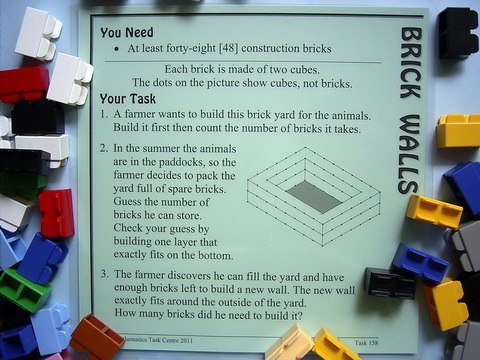
Brick WallsTask 158 ... Years 4 - 10SummaryBrick Walls neatly connects several mathematical areas - spatial perception, measurement and calculation of perimeter, area and volume and pattern and algebra. The task also makes connections to the real world of the bricklayer. The building blocks invite manipulation and the challenge of creating a building from the diagram seems achievable. The implied 'What happens if ...? questions on the card open the door to further investigation that leads to unexpected pattern and algebra.Materials
|
Content
|

IcebergA task is the tip of a learning iceberg. There is always more to a task than is recorded on the card. |
The first challenge is to interpret the diagram and decide how many bricks have been used to create the side length given that the dots in the diagram indicate where the half-bricks (or cubes) would be. As the building proceeds it becomes clear that a second layer of bricks is necessary to 'lock' the yard together, in the same way as is necessary when building a real wall. The experience helps students to understand why real bricks are not laid directly on top of each other, but are instead displaced by half a brick. This also helps them to see why real bricks are created in a 2:1:1 length to width to height ratio. Just because we see these things every day in our houses, doesn't mean we have ever thought about why they are so. When the yard is built, one layer will be built in one way and the other will be different so that the whole is held tightly. The layers will either be like this: 

ExtensionsOriginal Problem
What happens if we investigate yards built to store any given number of bricks? That is, if I tell you any any number of bricks I want to store can you tell me the best size of yard to build? In each case we would want the bricks to completely fill the inside yard and come just to the top of the wall. If we want to store one brick inside a wall, there is only one way. Stored Brick (S) = 1, Wall Bricks (B) = 5. 


Other Brick Problems
|
Whole Class InvestigationTasks are an invitation for two students to work like a mathematician. Tasks can also be modified to become whole class investigations which model how a mathematician works. |
This task relies on the brick ratio of 2:1:1. If you have a source of such material (those in the task are called The Little Architect Bricks) then the notes above will guide a whole class investigation. Once the class has been introduced to the lesson and explored the original problem together, the other questions listed could be the basis of an Investigation Guide. Red rods from a Cuisenaire set are the right proportions to use bricks, but there will be an issue distinguishing stored bricks and wall building bricks because they are only one colour. Perhaps the stored bricks could be given a white chalk mark. Also, the locking concept would not be apparent, hence the different ways of calculating the two layers of bricks may also not be so obvious. Another alternative could be to make an arrangement with the craft teacher for students to make sets of 'bricks' from square section timber. Some bricks could be bathed in vegetable dye to create a colour and the others could be left natural. At this stage, Brick Walls does not have a matching lesson on Maths300. |
Is it in Maths With Attitude?Maths With Attitude is a set of hands-on learning kits available from Years 3-10 which structure the use of tasks and whole class investigations into a week by week planner. |
The Brick Walls task is an integral part of:
|